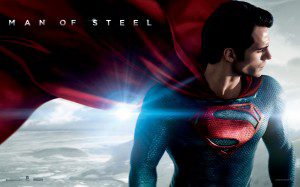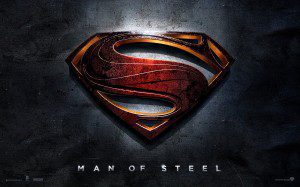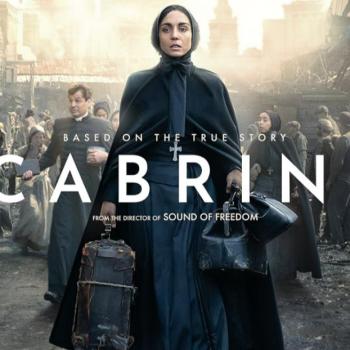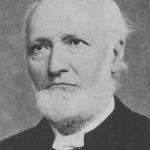Everyone is asking me if all the good parts of the new Superman movie, “Man of Steel” are in the trailer as so often happens these days.
Let me assure you, there’s no way you can put all the best parts of “Man of Steel” in a trailer!
A young man (Henry Cavell) works on a crab boat in the icy ocean waters of the North Pacific. He seems like a loner but gets the attention of everyone when an oil platform in the distance explodes and the young man leaps into the air and flies off to save the men working there. He has immense strength and the crew is dumbfounded. Who is he?
Next he is tending bar along a highway and rescues a waitress from the unwanted advances of a truck driver. He fixes things and then disappears.
The U.S. military is on alert because some “thing” has been detected by radar in ice that is thousands of years old. They believe it to be a Soviet era submarine, but it can’t be, can it?
A reporter from the Daily Planet comes snooping around and starts to put random pieces of a story together, like who is this man that does amazing things and then disappears? What’s the U.S. military doing in Canadian territory anyway? Her name is Lois Lane (Amy Adams) and she is persistent, courageous and somewhat annoying to her boss, the newspaper’s editor Perry White (Laurence Fishburne).
Flash back in time to a distant planet, Krypton, where a female struggles to give birth to a boy, Kal-El. She is Lara Lor-Van (Ayelet Zurer), wife of Jor-El (Russell Crowe). Soon after the baby’s birth they place him in a pod-like spacecraft and send him away to save him from the evil designs of General Zod (Michael Shannon). The citizens of Krypton have not only depleted their resources and want to colonize earth, but Zod cannot accept that Kal-El was conceived and born naturally rather than artificially as Kryptonians had been doing for eons in order to preserve racial purity.
As he sends the capsule into space, Jor-El blesses his son by saying, “You will give the people of Earth an ideal to strive towards. They’ll race behind you. They will stumble. They will fall. But in time, they will join you in the sun. In time, you will help them accomplish wonders.”
The space vehicle lands in cornfields belonging to Jonathan (Kevin Costner) and Martha (Diane Lane) Kent who live outside of Smallville, KS. They recover the child and name him Clark and hide the space craft in the barn. Jonathan and Martha know their son is special and his extraordinary gifts and abilities soon become evident. Kent is a loner at school who sits along the fence and reads Plato while the other kids pick on him, especially Pete (Jack Foley). But on a school trip when the bus goes off the road and sinks into a lake, Clark raises it up and goes back to get Pete who almost drowns. This heroic action on the part of Clark action changes Pete forever.
Fast forward again and Lois Lane tracks down the elusive Clark Kent. From that point on, when she learns his secret dual identity, everything changes.
“Man of Steel” in 2D and 3D is Warner Bros. latest rendering of arguably the most famous and popular comic book character ever, Superman. He was created by writer Jerry Siegel and artist Joe Shuster and was first published in 1938 as a comic book in the “Action Comics” Series, #1, that later became the “DC Comics” label that continues today. 2013 is the 75th anniversary of “Superman” and “Man of Steel” presents a colossal way to commemorate this pop culture event.
“Man of Steel” however is not your parents’ (or grandparents’) Superman story if they grew up with the 1978 version starring Christopher Reeve and Marlon Brando as Jor-El. The story is basically the same, but here writer David S. Goyer and director Zach Snyder, have switched the storyline up, down, back and forth to keep us interested. And it works. Henry Cavell as Clark Kent/Superman has an amazing physique and wears the upgraded version of his costume in very good health (in other words, he looks like he’s been photoshopped or he’s CGI but the costume I saw was real enough). The flying sequences go by very quickly but are beautifully crafted. To update the story, well for one, the filmmakers had to make major changes because there are no phone booths for Clark to change in. It will be fun to see how the sequel deals with this, for there will be one or more coming down Hollywood’s starry way. As for the music, by Hans Zimmer, it is “humble” as Zimmer put it, to reflect the story and this Superman’s persona.
Lois asks Superman about the glyph “S” that he wears on his chest. He answers that in Kryptonian the “S” is the symbol for “hope”. What is interesting to me is that in Latin the word for hope is “spes” – it begins with an “S”. A linguist was brought on board to develop a vocabulary in Kryptonian for the film and though about 300 words in this language are uttered in the movie I think subsequent viewings may be needed to identify all of them. Hope is a major theme in “Man of Steel.” (“Krypton” comes from the Greek for “hidden”.)
There has always been an incarnational aspect to the Superman story: he is both human and Kryptonian, he belongs to both worlds. He has been sent to earth by his father. He has great powers to do good, and his foster father Jonathan tells him often as a child and teenager to keep his abilities secret because people will not understand and will want to harm him. Many Christian reviewers believe that Superman is a Christ-figure, in that he has certain qualities that Jesus lived in the Gospels and lays down his life for others, that he reflects the attributes of Christ (rather than playing Jesus per se as in a Bible movie.) Some theological fans of the Superman story, on television or in movies, see a Trinitarian image in Jonathan as father, Clark as son, and Martha, who is Clark’s comforter and source of wisdom, in the role of the Holy Spirit. When all is racket and confusion, Martha whispers to Clark, “Listen to the sound of my voice.”
But Clark/Superman has two fathers who love and care for him, one in another world and one Jonathan Kent, who adopts him. The realization of this sets Clark off on a search for his identity, which is what lands him on the crab boat. But he sincerely wants to know what his vocation is, and in a conversation with a priest (Corburn Goss) in church, he asks for insight and guidance.
The fathers in “Man of Steel” are virtuous and worthy. This is a good film for Fathers Day. Producer Deborah Snyder (wife of director Zach) told me in an interview that she and her husband adopted a 10-month old baby and a two-year old toddler during the making of “Man of Steel” and this made them even more aware of the themes of fatherhood, parenting, and identity in the film and sensitive to how to portray these.
Adoption is certainly a strong theme in the film, and Clark’s search for his identity and his true parents, and his thoughtfulness toward his adoptive parents, reflect the journey of a man or woman who is searching for their birth parents.
Ms. Snyder also mentioned that there are many entry points for different audiences to connect with the film, whether its action, the themes mentioned above, including philosophy and social issues such as racism, aliens and “the other”, bullying, faith, love, family, and care for the earth.
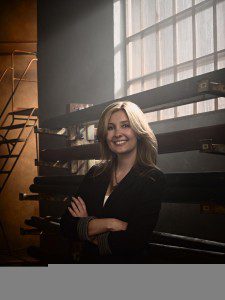
Russell Crowe is very good as Jor-El and I liked Laurence Fishburne as Perry White but we get to see very little of him. Michael Shannon, who often plays “evil characters” is Superman’s foe here as General Zod. He made everyone laugh at the press day when someone asked him where he gets his “evil” from. He said he goes right to the source, and dips down into the abyss and then drinks the lava he brings up. But he really isn’t “evil” in “Man of Steel” but a misguided soldier with one goal: to overpower the earth at any cost so Kryptonites could flourish because their planet had been consumed. His female counter-part Faora-Ul (Antje Traue) is a lean, mean fighting machine that is more of a robot than a conscious being. She is in sharp contrast to the strong, intelligent and caring characters of Martha and Lois. I hope that in future films they add more “real” female characters and make them all interesting.
I liked about two hours of “Man of Steel” and endured the 20-30 minutes of two intense fighting sequences that could have been deleted and not impacted the storyline one iota. When I mentioned this to Deborah Snyder she said that some of their test audiences wanted even more explosions and battles and crashes into skyscrapers, so the filmmakers had to try and reach a balance for a global audience. I become very bored at movies when the action is repetitive, cyclic and has no meaning, but that’s me.
In their efforts to create hometown USA the filmmakers placed many chain stores in the film. Watch closely and see how many logos and brands you can spot. I hope that the fine citizens of Kansas are not disappointed, but the rural parts of the movie were filmed in Plano, IL.
Much of the filming was done on Edwards Air Force Base and I am always leery when the U.S. military is involved in creating popular culture. If anything “Man of Steel” constructs a bond of trust between the military and the audience and not so much with the government that should be directing the military. It’s an interesting switch in emphasis, that the military – led by Superman – will save us.
At one point I said to myself, “This movie is so ‘Batmanish’” in the way the space ships and aliens are designed, and even in Superman’s quiet and reflective superhero demeanor. I discovered later that Christopher Nolan, who directed the last three Batman movies, co-wrote the story for this film and is one of the producers.
There is an over-abundance of fantasy or science fiction violence in “Man of Steel” but I suppose filmmakers believe they have to keep pushing the envelope so audiences will be interested. Superman has to make choices about what battles to fight and he really goes after Zod for insulting his foster mother, Martha. I would have appreciated a little more imagination and story and less action, but that’s me. And then there’s the glaring fact that for the first time in the Superman film franchise, Superman kills someone. For a Christian philosopher, as the film makes him out to be, this is unacceptable. But it is very politically correct for the USA.


